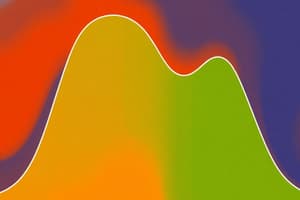Podcast
Questions and Answers
What does a measure of variability primarily describe about a distribution of scores?
What does a measure of variability primarily describe about a distribution of scores?
- The frequency of each score.
- The central tendency of the scores.
- The highest and lowest scores in the distribution.
- The differences between the scores and how clustered or spread out they are. (correct)
If all scores in a distribution are identical, what is the variability?
If all scores in a distribution are identical, what is the variability?
- Zero (correct)
- High
- Average
- Undefined
What does a measure of variability indicate about the distance between scores?
What does a measure of variability indicate about the distance between scores?
- The distance between the highest and lowest score.
- The sum of the distances between all scores.
- The expected distance between individual scores or between a score and the average. (correct)
- The average distance from any given value to the mean.
Which of the following is NOT a measure of variability?
Which of the following is NOT a measure of variability?
In the context of variability, what does it mean for scores to be 'clustered together'?
In the context of variability, what does it mean for scores to be 'clustered together'?
If a distribution has a large range, what does this imply about the variability of the scores?
If a distribution has a large range, what does this imply about the variability of the scores?
What distinguishes measures of variability from measures of central tendency?
What distinguishes measures of variability from measures of central tendency?
What is the primary benefit of using measures of variability in psychological research?
What is the primary benefit of using measures of variability in psychological research?
What does variability measure in the context of a distribution?
What does variability measure in the context of a distribution?
Which of these is considered the most unreliable measure of variability?
Which of these is considered the most unreliable measure of variability?
If a data set includes scores from 2 to 8, what is the range?
If a data set includes scores from 2 to 8, what is the range?
For a continuous variable, how can the range be defined?
For a continuous variable, how can the range be defined?
What is a primary issue with the range as a measure of variability?
What is a primary issue with the range as a measure of variability?
For a discrete variable concerning number of pets, with scores from 0 to 3, what is the range?
For a discrete variable concerning number of pets, with scores from 0 to 3, what is the range?
Which of these measures of variability is the most commonly used?
Which of these measures of variability is the most commonly used?
What is the connection between the range and the number of measurement categories when all scores are whole numbers?
What is the connection between the range and the number of measurement categories when all scores are whole numbers?
What does standard deviation measure in a dataset?
What does standard deviation measure in a dataset?
What is the first step in calculating the sum of squares (SS)?
What is the first step in calculating the sum of squares (SS)?
In the context of deviation scores, what does a negative sign indicate?
In the context of deviation scores, what does a negative sign indicate?
How does sample variability typically compare to population variability?
How does sample variability typically compare to population variability?
What is the significance of the sign in a deviation score?
What is the significance of the sign in a deviation score?
Why is it important for samples to be representative of their populations in inferential statistics?
Why is it important for samples to be representative of their populations in inferential statistics?
What does calculating the squared deviation involve?
What does calculating the squared deviation involve?
Which formula is referred to as the definitional formula in calculating SS?
Which formula is referred to as the definitional formula in calculating SS?
What is the purpose of adjusting the sample variance formula by using n – 1 instead of n?
What is the purpose of adjusting the sample variance formula by using n – 1 instead of n?
What does standard deviation primarily measure in a data distribution?
What does standard deviation primarily measure in a data distribution?
Why are degrees of freedom important in the calculation of sample variance?
Why are degrees of freedom important in the calculation of sample variance?
How is the estimated population variance calculated from a sample?
How is the estimated population variance calculated from a sample?
What kind of estimate does sample standard deviation provide for population variability?
What kind of estimate does sample standard deviation provide for population variability?
Which statement accurately describes how standard deviation relates to individual scores in a distribution?
Which statement accurately describes how standard deviation relates to individual scores in a distribution?
What does a higher standard deviation indicate about a data distribution?
What does a higher standard deviation indicate about a data distribution?
In a dataset, if the mean is close to several scores but far from others, what aspect does standard deviation help clarify?
In a dataset, if the mean is close to several scores but far from others, what aspect does standard deviation help clarify?
What is the rough percentage of scores within one standard deviation from the mean in a distribution?
What is the rough percentage of scores within one standard deviation from the mean in a distribution?
In a sample with a mean of M = 36 and a standard deviation of s = 4, what can you conclude about a score of X = 45?
In a sample with a mean of M = 36 and a standard deviation of s = 4, what can you conclude about a score of X = 45?
What is the main purpose of using the mean and standard deviation in statistics?
What is the main purpose of using the mean and standard deviation in statistics?
What is the term used in inferential statistics to describe the unexplained and uncontrolled differences between scores in a sample?
What is the term used in inferential statistics to describe the unexplained and uncontrolled differences between scores in a sample?
How does variability in a dataset affect the ability to see patterns in inferential statistics?
How does variability in a dataset affect the ability to see patterns in inferential statistics?
Which of the following is NOT a benefit of using the mean and standard deviation to analyze data?
Which of the following is NOT a benefit of using the mean and standard deviation to analyze data?
What is the relationship between variance and error variance in inferential statistics?
What is the relationship between variance and error variance in inferential statistics?
Why is it important to consider variability in inferential statistics?
Why is it important to consider variability in inferential statistics?
Flashcards
Range
Range
The distance between the smallest and largest scores in a distribution.
Variability
Variability
How much an individual score or group of scores represents the entire distribution. Important for inferential statistics, especially with small samples.
Measures of Variability
Measures of Variability
Measures that describe how spread out a distribution is.
Range (Continuous)
Range (Continuous)
Signup and view all the flashcards
Range (Discrete)
Range (Discrete)
Signup and view all the flashcards
Disadvantage of Range
Disadvantage of Range
Signup and view all the flashcards
Standard Deviation
Standard Deviation
Signup and view all the flashcards
Variance
Variance
Signup and view all the flashcards
Frequency Distribution
Frequency Distribution
Signup and view all the flashcards
Median
Median
Signup and view all the flashcards
Mode
Mode
Signup and view all the flashcards
Mean
Mean
Signup and view all the flashcards
What is Standard Deviation?
What is Standard Deviation?
Signup and view all the flashcards
How is Standard Deviation calculated?
How is Standard Deviation calculated?
Signup and view all the flashcards
Why is Standard Deviation preferred over Range?
Why is Standard Deviation preferred over Range?
Signup and view all the flashcards
What is the sum of squares (SS)?
What is the sum of squares (SS)?
Signup and view all the flashcards
What is a deviation score?
What is a deviation score?
Signup and view all the flashcards
What does the deviation score tell us?
What does the deviation score tell us?
Signup and view all the flashcards
How does sample variability differ from population variability?
How does sample variability differ from population variability?
Signup and view all the flashcards
Degrees of Freedom (df)
Degrees of Freedom (df)
Signup and view all the flashcards
How is sample standard deviation adjusted?
How is sample standard deviation adjusted?
Signup and view all the flashcards
Sample Variance Adjustment
Sample Variance Adjustment
Signup and view all the flashcards
Sample Variance (s²)
Sample Variance (s²)
Signup and view all the flashcards
Standard Deviation (s)
Standard Deviation (s)
Signup and view all the flashcards
Standard Deviation as a Descriptive Statistics
Standard Deviation as a Descriptive Statistics
Signup and view all the flashcards
Standard Deviation as a Measure of Distance
Standard Deviation as a Measure of Distance
Signup and view all the flashcards
Mean and Standard Deviation Together
Mean and Standard Deviation Together
Signup and view all the flashcards
Variance (in statistics)
Variance (in statistics)
Signup and view all the flashcards
Error Variance
Error Variance
Signup and view all the flashcards
Inferential Statistics
Inferential Statistics
Signup and view all the flashcards
Standard Deviation (Descriptive)
Standard Deviation (Descriptive)
Signup and view all the flashcards
Variability (Inferential)
Variability (Inferential)
Signup and view all the flashcards
Goal of Inferential Statistics
Goal of Inferential Statistics
Signup and view all the flashcards
Mean and Standard Deviation (Importance)
Mean and Standard Deviation (Importance)
Signup and view all the flashcards
Study Notes
Lesson Objectives
- Discuss the purpose of variability in psychological research
- Compute and interpret different measures of variability
Overview
-
Measures of central tendency (like mean and median) summarize large datasets but don't show the whole picture
-
Not everyone is average; some perform above or below average
-
Variability describes how different scores are in a distribution (spread out or clustered together)
-
A measure of variability gives an objective description of differences between scores
-
Ways to measure variability include: standard deviation, variance, and range
Overview
- Variability in stats has the same meaning as everyday language: something that's not the same
- In statistics, the goal is to quantify the amount of variability in a dataset or distribution
- If all scores are the same, there's no variability
Overview
- Variability quantifies differences between scores; it describes how spread out or clustered scores are
- Variability is often expressed in terms of distance between scores
- It shows how much distance or difference to expect between any individual score and another score and also between the individual score and the mean.
Overview
- Variability measures the representation of an individual score(or group of scores) within the entire distribution.
- It's crucial for inferential statistics where small samples are used to understand the populations they are drawn from.
Measures of Variability
- Range
- Variance
- Standard Deviation
The Range
- Range is the difference between the highest and lowest score
- It represents the entire span of the scores in a dataset.
- When scores are continuous, range = URL (upper real limit of the largest score) - LRL(lower real limit of the smallest score).
- Range can be determined by counting the number of measurement categories when the measures are numerical scores (e.g. number of children in a family: 0, 1, 2, 3, or 4 = 5 points).
The Range
- Using range to measure variability is straightforward, simple and obvious, where you find the spread by calculating the distance between the maximum and minimum scores.
- The range's drawback is that it's solely determined by the highest and lowest scores, ignoring all the middle scores.
The Range
- The range in a distribution only considers the extreme values, not all the scores
- Range is a crude and unreliable measure of variability
- It usually doesn't give a precise idea about the spread of the data given the scores are not all equal or the same
Standard Deviation and Variance for a Population
- Standard Deviation is the most frequent and important measure of variability.
- Standard deviation considers the average difference from the mean.
- Values clustered around the mean show low variability; widely scattered values show high variability
Standard Deviation and Variance for a Population
- Standard deviation is the same for samples and populations, but calculations differ slightly.
Standard Deviation and Variance for a Population
- Deviation is the distance of a score from the mean (score - mean).
- A plus sign means above the mean; a minus sign means the score is below the mean
Standard Deviation and Variance for a Population
- The sign of a deviation score tells the direction (above or below the mean) and the number tells how far away the score is from the mean
Standard Deviation and Variance for a Population
- Sum of Squared Deviations (SS) is the sum of the squared deviations of individual scores from population mean. (Σ(x - μ)²)
- Computational formula: SS = ΣX² - (ΣX)²/N
Standard Deviation and Variance for a Population
- Population variance is calculated by dividing the Sum of Squared Deviations (SS) by the number of scores (N). σ² = SS/N
- Population standard deviation = √Variance
Standard Deviation and Variance for a Population
- Example population variance: Using data (1, 0, 6, 1), the population variance is calculated as 5.50. The population standard deviation is 2.345
Standard Deviation and Variance for Samples
- Inferential stats seeks to draw general conclusions from sample data regarding populations
- Samples are assumed to represent their populations
- Samples are generally less variable than their populations
Standard Deviation and Variance for Samples
- Sample variability is often less than population variability
- The bias in estimates is toward underestimation of the population value
Standard Deviation and Variance for Samples
- Formula for calculating variability in samples:
- First: take deviation score of each value: (value-mean)
- Second: square each deviation: (value - mean)2
- Third: total squared deviation: SS = Σ(Χ – M)² (n - 1 = degrees of freedom for sample)
- Computational formula: SS = ΣX² - (ΣX)² / n
Standard Deviation and Variance for Samples
- Sample variance: s²= SS / (n - 1)
- Sample Standard Deviation: s = √ Variance s²
Standard Deviation and Variance for Samples
- Example: Using data (1, 6, 3, 8, 7, 6), the sample variance is 6; and the sample standard deviation is 2.45.
Degrees of Freedom (df)
- Degrees of freedom (df) = the number of values free to vary when calculating a statistic
- In samples, df = n-1, which corrects for the "biased" sample variance
Degrees of Freedom (df)
- Dividing by (n - 1) in sample variance delivers more precise population variance, rather than an underestimation
Standard Deviation and Descriptive Statistics
- Standard deviation describes how variable or spread out a dataset's scores are.
- Behavioural scientists need to consider the variation amongst people/animals due to differences in traits, opinions, IQ, talents etc.
Standard Deviation and Descriptive Statistics
- Standard deviation shows the average or typical distance of a data point to the mean. Some are close, some are far.
Standard Deviation and Descriptive Statistics
- Standard deviation calculates the picture of the entire distribution by identifying the relationships between individual scores
- In an example: score X = 34 is close to the centre; score X = 45 is further in the right tail
Standard Deviation and Descriptive Statistics
- Approximately 70% of the scores in a distribution lie within one standard deviation of the mean, while almost all (95%) fall within two standard deviations of the mean
Variance and Inferential Statistics
- The goal of inferential stats is to identify significant patterns
- Whether observed sample patterns reflect population patterns or simply random fluctuations; variability is important
Variance and Inferential Statistics
- Low variability means clear observed patterns; high variability obscures patterns
- Variance in a dataset or sample can be classified as "error variance". This refers to inconsistencies that are unexplained. This error increases, making clear patterns difficult to see in data.
Summary
- Variability measures how spread out or clustered the scores in a distribution are.
- Range is the distance between the highest and lowest score.
- Variance is the average of the squared deviations from the mean.
- Standard deviation is the square root of the variance; it represents the standard distance from the mean.
Additional formulas
- Population standard deviation σ = √(SS/N)
- Population variance σ² = (SS/N)
- Sample variance s² = (SS/(n-1))
- Sample standard deviation s = √(SS/(n-1))
Studying That Suits You
Use AI to generate personalized quizzes and flashcards to suit your learning preferences.




